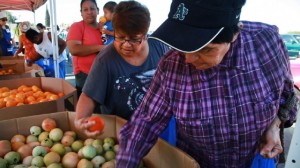 As extreme drought continues to grip much of the state, the California Department of Social Services has announced that food banks in 24 drought-affected counties will be receiving shipments of food assistance. The first $5.1 million in food assistance will begin to hit food bank shelves in early May, delivered directly to drought-impacted communities.
As extreme drought continues to grip much of the state, the California Department of Social Services has announced that food banks in 24 drought-affected counties will be receiving shipments of food assistance. The first $5.1 million in food assistance will begin to hit food bank shelves in early May, delivered directly to drought-impacted communities.
The announcement represents the first wave of drought-related food assistance to be delivered to communities throughout California this year. The $687 million emergency drought legislation, signed by Governor Edmund G. Brown Jr. last month, included $25 million in food assistance for the counties most impacted by the drought.
Shipments will be sent to counties where the unemployment rate is higher than the 2013 statewide average, and have a higher share of agricultural workers than the state as a whole. These counties include: Amador, Butte, Colusa, Fresno, Glenn, Kern, Kings, Lake, Lassen, Madera, Merced, Modoc, Monterey, San Benito, San Joaquin, Santa Cruz, Sierra, Siskiyou, Stanislaus, Sutter, Tehama, Tulare, Yolo and Yuba. A study on effects of the drought by the University of California, Davis has been initiated and, once completed, will help refine the locations of future food assistance distributions.
In addition to drought-related food assistance, families and individuals who are expecting long-term impacts of the drought will be offered information and assistance in applying for the CalFresh Program. CalFresh is a federal program designed to help families put healthy and nutritious food on the table.
Governor Brown has called on all Californians to reduce their water use by 20 percent –visit SaveOurH2O.org for ideas about how to conserve, and visit Drought.CA.Gov to learn more about how California is dealing with the effects of the drought.


